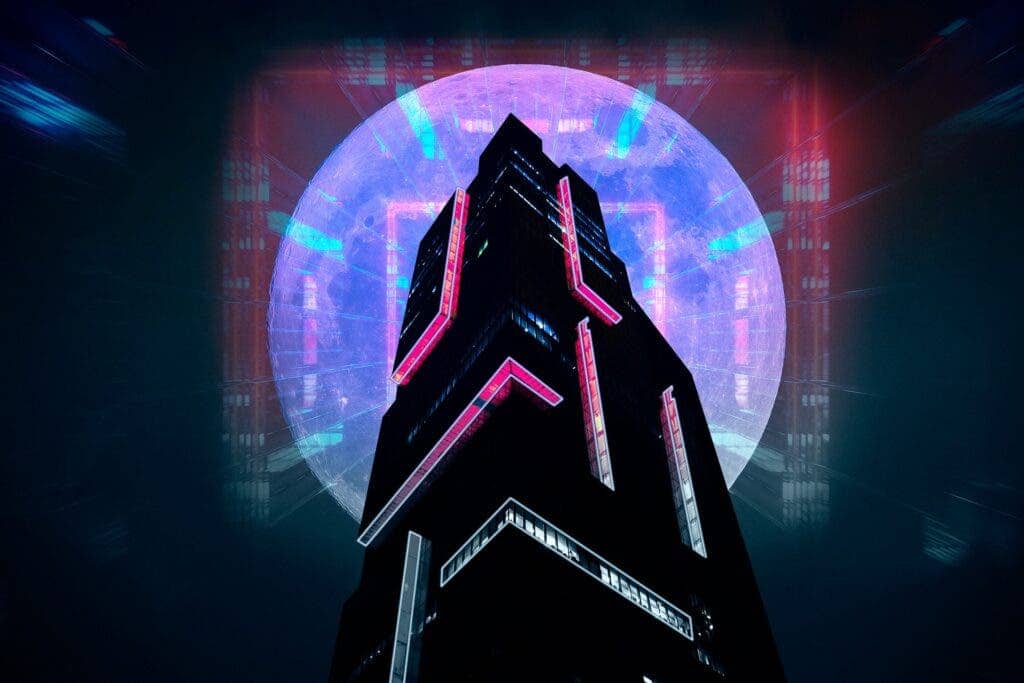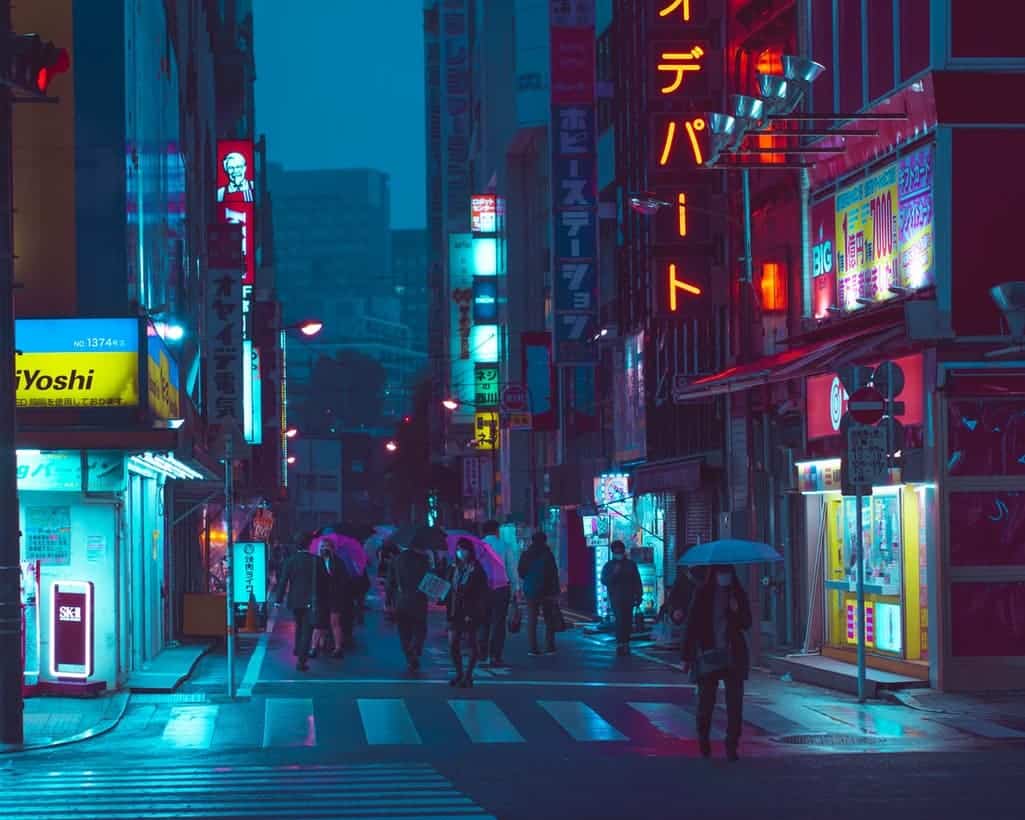In its simplest form, cyberpunk is a science fiction subgenre that brings together advanced, futuristic technology, with a decline in societal decay. Think of a society featuring advanced artificial intelligence, cybernetics, massive skyscrapers, but with many people living in slums or being controlled and lacking social freedom. But cyberpunk isn’t only a sci-fi subgenre, but also a cultural movement that has some influence on things like entertainment, design, gaming, architecture, fashion, and technology. In fact, you could argue we’re already living in a cyberpunk world.

Cyberpunk often features a flashy visual theme and an underlying dystopian theme of this genre. It depicts a world where technological development is at its peak, artificial intelligence co-exists with humans, people have access to robotic brains and body implants — but at the same time, the social order is heavily disturbed, corrupt multinational corporations (or machines) own and controls everything, crime has become an integral part of society, and most of the population has a poor standard of living.
The “high tech, low life” concept of a cyberpunk world has been popularized by comics, films, animes, and books of the same genre. Writers like Philip K. Dick, William Gibson, Katsuhiro Otomo, Bruce Sterling, Rudy Rucker, and many others in the 70s and 80s introduced different characteristics. Thin neon city lights, electronic music, dark streets, cyborgs, holograms, rugged and vibrant clothing style, drug syndicates, cramped apartments, illegal tech markets, and a broke society) — those are the tell-tale of a cyberpunk world that later became symbols of the genre. Cyberpunk protagonists are typically rebels, hackers, reluctant heroes clinging to individuality in a world where invasive control is the norm. Unsurprisingly, many see cyberpunk as more than just an artistic current, but rather as a social critique.
Cyberpunk elements in the real world
Remarkably, many famous novels, anime, and movies in the cyberpunk style from the 80s and 90s that popularized the genre are set in the current time. Ridley Scott’s iconic sci-fi flick Blade Runner shows events from 2019, Software, a critically acclaimed cyberpunk novel from Rudy Rucker is based in the year 2020, P.D. James’ highly popular dystopian fiction, Children of Men is set in 2021 (its movie adaptation is based in 2027), whereas Bruce Sterling’s thrilling sci-fi book Islands in the Net tells a dark futuristic story from the year 2023.
But cyberpunk is still going strong now, we’ve just pushed the date by a few years.

Learning from cyberpunk
Science fiction is reality ahead of schedule, Syd Mead, concept designer of tron and blade runner once famously said. So is cyberpunk a realistic expectation of what’s to come?
Researchers have suggested in the past that technology can fuel economic inequality. Big tech companies, in particular, are fueling inequality, and although technology as a whole is alleviating poverty, there are fears that it could fuel rampang social inequality. In addition, while making us richer, technology can also be used to control and impose dystopian measures — as we’re already starting to see in China, for instance.
In fact, what makes cyberpunk different from other sci-fi genres is its ability to manifest our fears associated with hi-technology and the perils it could bring, perils such as over-capitalism, drug addiction, gadget dependency, media oversaturation, crime, and data privacy. So while cyberpunk is a literary and artistic current, we’re definitely starting to see some of its signature trademarks in the real world.

Cyberpunk in the real world
Aesthetically, cyberpunk is distinctive in its neon urban lights. Perhaps unsurprisingly, cyberpunk scenery is becoming more and more common, as some of its underlying aspects are also creeping into our world. If we look around carefully, it’s not hard to find various cyberpunk elements around us. Here are just a few examples.
- A cyberpunk world where powerful multinational corporations much of society. In the real world, multinational tech corporation like Google, Facebook, and Amazon control the web and most of our digital assets. A normal internet user may never know even if his data is sold on the dark web or his privacy is compromised on some level. Moreover, from time to time, these trillion-dollar tech companies are accused of putting their profits above democratic principles. Recently, an ex-Facebook (now Meta) employee Frances Haugen told CBS in an interview “The thing I saw at Facebook over and over again was there were conflicts of interest between what was good for the public and what was good for Facebook. And Facebook, over and over again, chose to optimize for its own interests, like making more money.” Oh, and we’re just beginning to see their influence.
- Places like Las Vegas, Chongqing city in China, Japan’s major economic centers Tokyo and Osaka, and various parts of Singapore (Golden Mile complex), and Hong Kong (such as Montane Mansion and Monster building) are loaded with visual cyberpunk-ish aesthetics such as giant neon signboards, skyscrapers, stacked apartments, dark alleys, large advertisement screens, neon-lit commercial complexes, and crowded streets. In fact, Tokyo has been the inspiration for various fictional cyberpunk cities in video games and movies.

- Chatbots and voice assistants like Alexa and Siri that monitor our preferences using algorithms are an example of artificial intelligence co-existing in the real world. Similarly, the ability of social media and online advertisements to manipulate our emotions, thoughts, and decision-making ability indicates how deep technology has entered into our lives.
- A popular cyberpunk video game called Cyberpunk 2077 features an in-game personalized virtual world called Braindance. Though we have not been able to develop a futuristic VR experience as advanced as Braindance, VR devices in the present also allow us to experience virtual reality. Games and applications like Fortnite, Decentraland, Second Life, and Facebook’s newly launched Horizon World are examples of virtual worlds existing within our own world.
Moreover, prosthetic body parts, augmented reality-based applications (like the game Pokemon GO), cyberpunk-themed clothing (such as cybergoth, futuristic gothic, etc), as well as the advent of brain chips (such as Neuralink), machine learning, smart weapons, humanoids (like Sophia and Ameca) and Internet of Things (IoT)are some of the developments that are taking place in the real world but also share a striking resemblance to various elements shown in the cyberpunk themes of Terminator, Akira, Blade Runner, Alita Battle Angel, and Ghost in the Shell.
Cyberpunk and transhumanism
Although to many people, cyberpunk is merely an aesthetic style, we’ve already mentioned that there’s some hardcore social critique to it. The main reason for this is that cyberpunk involves heavy philosophical concepts.
Transhumanism is believed to be the core philosophy behind the development of the cyberpunk genre. Transhumanism is a social, philosophical, and intellectual movement that favors the invention and use of advanced innovations that can enhance human ability. Basically, transhumanists want us to evolve past our human nature using technology. Any technology capable of improving intelligence, physical strength, health, cognitive ability, memory, and lifespan of humans is part of transhumanist progress.

Transhumanist thinkers predict emerging technologies and examine their possible positive and negative impacts on human society. Writers in the 70s and 80s are also believed to have analyzed the influence of the internet, terrorism, drugs, computers, cybersecurity, and sexual revolution while working on various cyberpunk themes. This can also be understood from the fact that the nature of the protagonist in various such works is of a transhuman, for example, Ghost in the Shell’s Motoko Kusanagi was also a transhuman.
However, due to its dystopian nature, most of the fictional works in the cyberpunk genre reveal a negative side of a transhumanist approach. Novels and films like Do Androids Dream of Electric Sheep, Alita: Battle Angel, Cowboy Bebop, Terminator, etc shows how advanced technologies can promote corruption, greed, destruction and ultimately lead to a chaotic world. According to Robert M. Geraci, who is a professor of religious studies at Manhattan College, “cyberpunk as a genre attempts to caution against transhumanism by exposing the problematic elements of the social economy that supports it.”
Nobody wants to live in a dystopian world (especially after the pandemic) but in the coming years, it would be really interesting to see if some popular cyberpunk technologies such as cyborgs, laser weapons, advanced VR devices, and flying cars become a reality.


